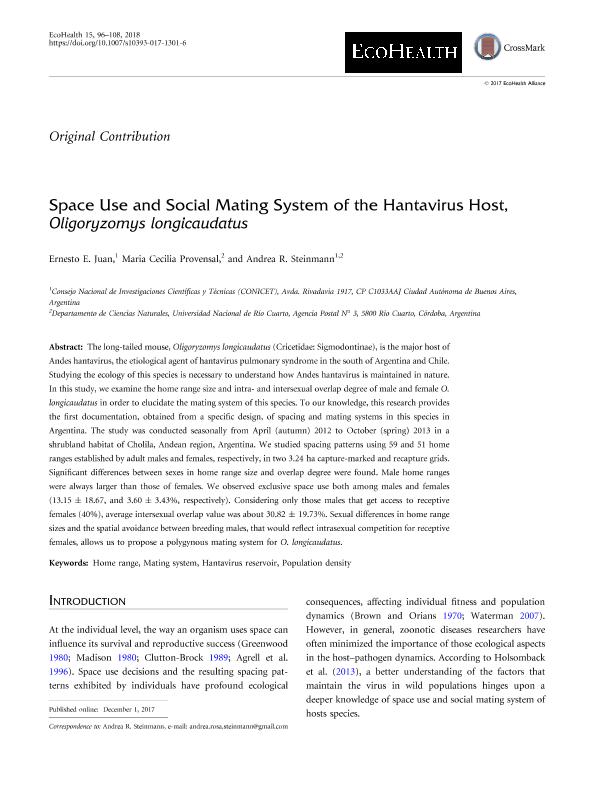Artículo
Space use and social mating system of the Hantavirus host, Oligoryzomys longicaudatus
Fecha de publicación:
03/2018
Editorial:
Springer
Revista:
Ecohealth
ISSN:
1612-9202
e-ISSN:
1612-9210
Idioma:
Inglés
Tipo de recurso:
Artículo publicado
Clasificación temática:
Resumen
The long-tailed mouse, Oligoryzomys longicaudatus (Cricetidae: Sigmodontinae), is the major host of Andes hantavirus, the etiological agent of hantavirus pulmonary syndrome in the south of Argentina and Chile. Studying the ecology of this species is necessary to understand how Andes hantavirus is maintained in nature. In this study, we examine the home range size and intra- and intersexual overlap degree of male and female O. longicaudatus in order to elucidate the mating system of this species. To our knowledge, this research provides the first documentation, obtained from a specific design, of spacing and mating systems in this species in Argentina. The study was conducted seasonally from April (autumn) 2012 to October (spring) 2013 in a shrubland habitat of Cholila, Andean region, Argentina. We studied spacing patterns using 59 and 51 home ranges established by adult males and females, respectively, in two 3.24 ha capture-marked and recapture grids. Significant differences between sexes in home range size and overlap degree were found. Male home ranges were always larger than those of females. We observed exclusive space use both among males and females (13.15 ± 18.67, and 3.60 ± 3.43%, respectively). Considering only those males that get access to receptive females (40%), average intersexual overlap value was about 30.82 ± 19.73%. Sexual differences in home range sizes and the spatial avoidance between breeding males, that would reflect intrasexual competition for receptive females, allows us to propose a polygynous mating system for O. longicaudatus.
Palabras clave:
HANTAVIRUS RESERVOIR
,
HOME RANGE
,
MATING SYSTEM
,
POPULATION DENSITY
Archivos asociados
Licencia
Identificadores
Colecciones
Articulos(CCT - CORDOBA)
Articulos de CTRO.CIENTIFICO TECNOL.CONICET - CORDOBA
Articulos de CTRO.CIENTIFICO TECNOL.CONICET - CORDOBA
Citación
Juan, Ernesto Ezequiel; Provensal, María Cecilia; Steinmann, Andrea Rosa; Space use and social mating system of the Hantavirus host, Oligoryzomys longicaudatus; Springer; Ecohealth; 15; 1; 3-2018; 96-108
Compartir
Altmétricas




